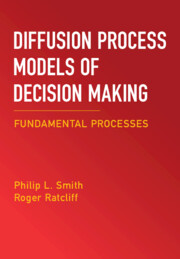Book contents
- Frontmatter
- Dedication
- Contents
- List of Figures
- Preface
- 1 Overview
- 2 Basic Concepts and Data
- 3 Sequential-Sampling Models of Decision Making
- 4 Obtaining Predictions for Diffusion Models
- 5 Empirical Assessment of Sequential-Sampling Models
- 6 Time-Varying Diffusion Models, I. Time Pressure, Urgency, Collapsing Boundaries, and Optimality
- 7 Diffusion Models for Time-Controlled Processing Tasks
- 8 Time-Varying Diffusion Models, II. Detection and Simple RT
- 9 Diffusion Processes Driven by Time-Varying Stimulus Representations in Visual Working Memory
- 10 Neural Diffusion Models, I. Network and Dynamical System Models
- 11 Neural Diffusion Models, II. Poisson Shot Noise and Related Models
- 12 Diffusion Models for Continuous-Outcome Decision Tasks
- 13 Response Confidence
- 14 EZ and Moment Models, Multialternative Decisions, and Expanded Judgment Tasks
- References
- Index
9 - Diffusion Processes Driven by Time-Varying Stimulus Representations in Visual Working Memory
Published online by Cambridge University Press: 26 October 2025
- Frontmatter
- Dedication
- Contents
- List of Figures
- Preface
- 1 Overview
- 2 Basic Concepts and Data
- 3 Sequential-Sampling Models of Decision Making
- 4 Obtaining Predictions for Diffusion Models
- 5 Empirical Assessment of Sequential-Sampling Models
- 6 Time-Varying Diffusion Models, I. Time Pressure, Urgency, Collapsing Boundaries, and Optimality
- 7 Diffusion Models for Time-Controlled Processing Tasks
- 8 Time-Varying Diffusion Models, II. Detection and Simple RT
- 9 Diffusion Processes Driven by Time-Varying Stimulus Representations in Visual Working Memory
- 10 Neural Diffusion Models, I. Network and Dynamical System Models
- 11 Neural Diffusion Models, II. Poisson Shot Noise and Related Models
- 12 Diffusion Models for Continuous-Outcome Decision Tasks
- 13 Response Confidence
- 14 EZ and Moment Models, Multialternative Decisions, and Expanded Judgment Tasks
- References
- Index
Summary
Chapter 9 describes the integrated system model of perception, attention, visual working memory (VWM), and decision making, which characterizes performance in perceptual tasks that use brief, backwardly masked stimuli. Decisions in these tasks take longer to make than the time during which the stimulus is physically present. After an initial, time-varying, period of stimulus encoding, the evidence entering the decision process appears not to decay after the stimulus is masked, although the decision process is not yet complete. The lack of decay implies that the decision process is driven by stable representations in VWM and not by the decaying perceptual trace. The integrated system model assumes that drift and diffusion rates depend on a time-varying VWM trace that is formed under the control of attention. The chapter describes fits of the integrated system model to data from these kinds of tasks. The second part of the chapter describes two related models for decisions about stimuli presented in dynamic noise: the time-changed diffusion model and the release from inhibition model. The models capture the large changes in response time distributions produced by these stimuli.
Keywords
Information
- Type
- Chapter
- Information
- Diffusion Process Models of Decision MakingFundamental Processes, pp. 220 - 254Publisher: Cambridge University PressPrint publication year: 2025
